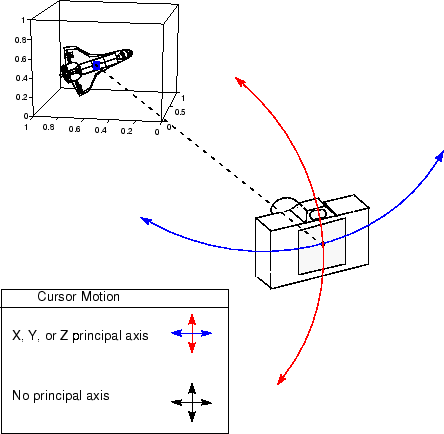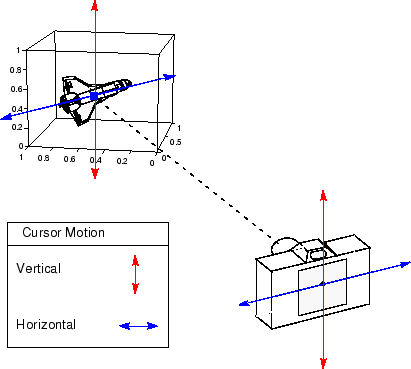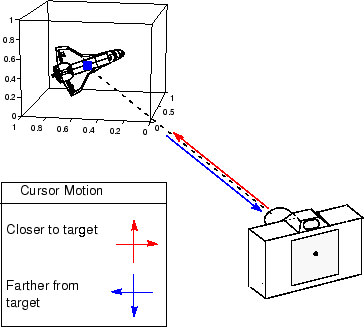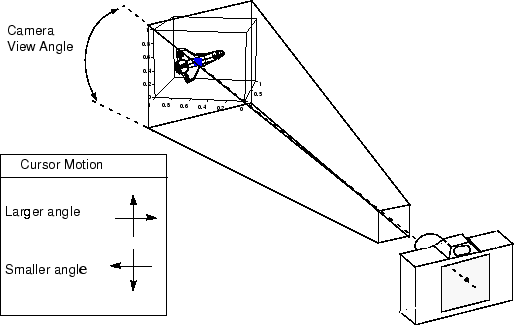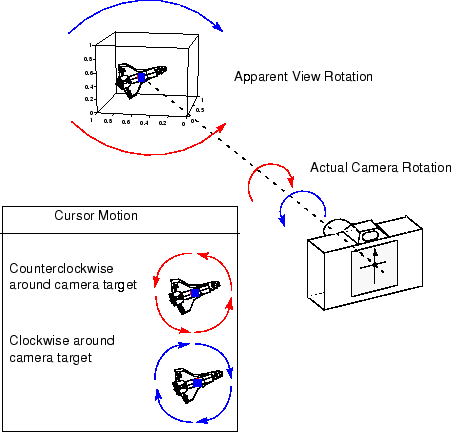使用相机工具栏控制视图
您可以使用相机工具栏以交互方式执行许多查看操作。显示工具栏,并通过从图窗中的视图菜单中选择相机工具栏,以交互方式设置相机移动模式、主轴、场景灯光、投影类型和回放设置。也可以使用 cameratoolbar 函数。

注意
默认情况下,MATLAB® 以适合图窗窗口的纵横比显示绘图。当您在场景中移动相机时,此行为会导致三维图形畸变。为了避免可能的畸变,相机工具栏会自动切换到三维可视化模式。您也可以使用命令 axis vis3d 启用三维可视化模式。
相机移动控件
相机移动模式允许您以交互方式操作相机坐标轴。通过选择相机工具栏中的按钮来设置相机移动模式。或者,使用命令 cameratoolbar("SetMode",mode) 指定模式。
在下表中各图所示的运动中,相机保持指向相机目标。有关相机移动中涉及到的图形属性的说明,请参阅相机图形术语。
| 相机移动模式 | 图 |
|---|---|
|
|
| 不适用 |
|
|
|
|
|
|
|
|
|
|
主轴选择器
场景的主轴定义屏幕上向上的方向,并限制相机沿平行和垂直于主轴的轴的移动。如果您的数据是针对特定坐标轴定义的,则指定主轴很有用。
环移相机和平转/纵转相机模式的工作方式基于特定的坐标轴。在相机工具栏中为受限制移动选择主轴(主轴 X  、主轴 Y
、主轴 Y  或主轴 Z
或主轴 Z  )或无轴(无主轴
)或无轴(无主轴  )。
)。
对于 z 轴,这是三维视图的默认主轴:
水平游标移动导致相机绕垂直轴旋转,该轴通过
CameraTarget属性定义的点并平行于 z 轴。垂直游标移动导致相机绕水平轴旋转,该轴垂直于由 z 轴和通过由
CameraTarget和CameraPosition属性定义的点的线定义的平面。
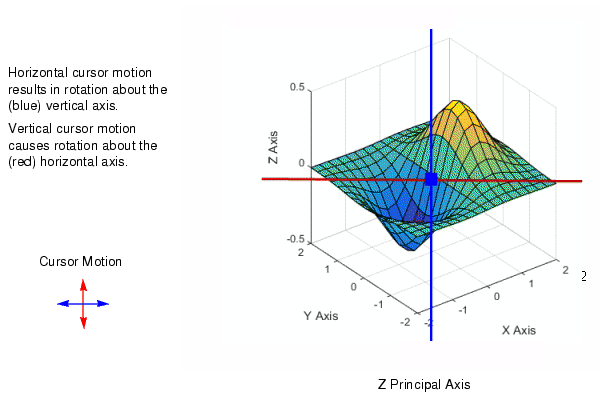
场景灯光
场景灯光将灯光投射到坐标区中的任何补片和曲面对象上。通过在相机工具栏中选择切换场景灯光  来创建和切换光源。通过在相机工具栏中选择环移场景灯光
来创建和切换光源。通过在相机工具栏中选择环移场景灯光  来移动场景灯光。坐标区只能有一个场景灯光。
来移动场景灯光。坐标区只能有一个场景灯光。
投影类型
MATLAB 使用图形投影在二维屏幕上显示三维对象。通过在相机工具栏中选择正交投影  或透视投影
或透视投影  切换投影类型。默认情况下,投影类型为正交。
切换投影类型。默认情况下,投影类型为正交。
正交投影将观察体投影为矩形平行六面体(有六个矩形面的长方体)。与相机之间的相对距离不影响对象的大小。当需要保持对象的实际大小以及对象之间的角度时,这种投影方式非常有用。
透视投影将观察体投影为棱锥的截头锥体(平行于底部截掉头部的棱锥)。距离会产生前缩透视效果,距相机越远的对象越小。当您要显示真实对象的逼真视图时,这种投影方式非常有用。
有关详细信息,请参阅了解视图投影。
重置和停止
通过选择相机工具栏中的重置相机和场景灯光  或停止移动相机/灯光
或停止移动相机/灯光  重置或停止相机和场景灯光。
重置或停止相机和场景灯光。
重置会将相机和灯光还原到交互开始时的状态。
停止会导致相机和灯光停止移动,这在应用了太多的游标移动时会很有用。

